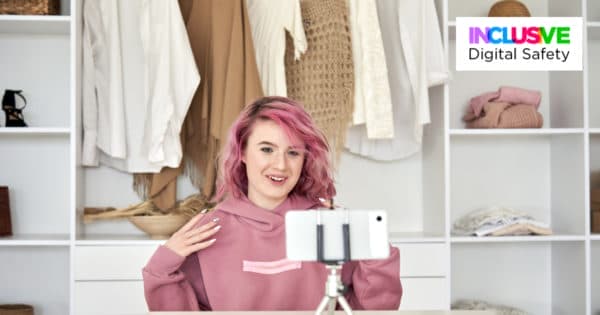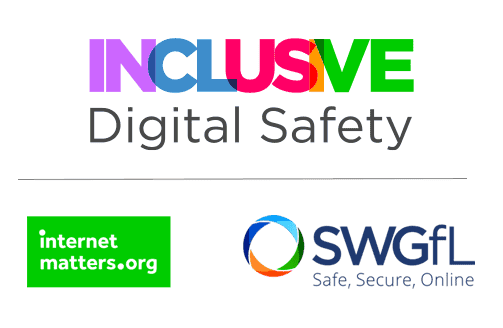
Contacting the National Crime Agency CEOP Command
A guide to connecting and sharing online
For LGBTQ+ children and young people, connecting and sharing online is a vital way to interact with peers, educate themselves and find solutions to issues that friends or family may not understand.
However, there are also areas of risk for young people within the LGBTQ+ community when interacting online.

Life on social media is an important part of growing up today. For LGBTQ+ children and young people, it can often be a lifeline.
Connections help young people educate themselves on their sexuality, or discover friends and connections in a similar position. It can also help them affirm they are not alone.
Social media and connection online offers support to LGBTQ+ children and young people in the following ways:
Young people questioning their identity or struggling can find communities online to support them. Social media platforms allow them to find communities through hashtags or groups.
This helps LGBTQ+ young people find a sense of belonging they might not have offline. If they don’t know anyone else offline who identifies as LGBTQ+, this is especially important.
The online space, and social media in particular, provides young people with the tools to authentically express themselves. This opportunity is especially important if they’re unable to express themselves offline.
Sharing with LGBTQ+ communities can provide them with the support they might not get offline.
If a child or young person is questioning their identity, they might not want to share with their family or friends. The online space provides them a way to learn about the LGBTQ+ community and put words to how they feel.
LGBTQ+ is a spectrum that includes well-known identities such as lesbian, gay and bisexual. However, it includes other identities like asexual, trans, non-binary and pansexual. These terms often help young people find a way to understand how they feel.
Teenagers often use the online space to learn about relationships. Online dating through social media is finding popularity as well.
While there are risks, LGBTQ+ teens can benefit from finding safe spaces online to make connections. This allows them to build meaningful connections with others through shared experiences.
Unlike some experiences offline, the online space might allow them to show their true selves away from potential judgement of their peers.
There are risks and challenges that go hand in hand with the benefits of existing in online spaces. While this applies to all children, those who are a part of the LGBTQ+ might experience unique risks. Potential harms include:
Children and young people open about their LGBTQ+ identity might come across cyberbullying, hateful content and hate speech online. Additionally, closeted LGBTQ+ young people might continue hiding who they are if this content crosses their feed.
Hateful content can look like text posts, homophobic or transphobic memes and videos. It often spreads due to social media algorithms and requires important critical thinking and digital literacy skills.
Over a three-year period, Twitter users published 1.5 million transphobic tweets. A culture of transphobia or homophobia online emboldens some people to harass, bully or discriminate against the LGBTQ+ community. As such, young people within this community might fall victim, leading to challenges with their wellbeing and self-image.
Communicating with people online runs the risks of connecting with users who seek to harm. This could include homophobic or transphobic people who target vulnerable LGBTQ+ young people.
If a young person feels a particular connection to someone, they might try to meet offline. Unfortunately, this could lead to bodily harm, especially if the LGBTQ+ young person is a victim of grooming.
A research report from The Brook revealed that more gay young people (9.9%) compared to straight young people (4.5%) reported meeting up with an online contact who was not who they said they were.
As a part of online hate, children and young people within the LGBTQ+ community often face greater risk of sexual harassment or abuse.
They might also find themselves the victims of unwanted sexual behaviour such as unsolicited nude images.
Both strangers and peers from school could be perpetrators. Child-on-child abuse includes this kind of behaviour between young people under 18.
Inappropriate content, such as violent and hateful videos, are a potential risk online. These things might come up as they search for information or through private messages on social media networks. Anti-LGBTQ+ messaging and misinformation can mislead children and young people discovering their identity.
Additionally, pornographic content could impact LGBTQ+ children and young people’s views of sex and relationships. Pornography often shows the control or domination over another person and might include violent behaviours. If this is the only reference they have, they might misunderstand what healthy relationships look like.
Sexual and criminal exploitation are both forms of grooming. LGBTQ+ young people might find themselves victims of sexual exploitation or harm because of their identity.
Some LGBTQ+ young people deliberately use adult sites because they think it’s an easier way to meet people, explore their sexuality or feel accepted. However, this leads them open to serious harms and the potential to be groomed. Adult dating apps, for example, might feel like the only online space made specifically for LGBTQ+ people.
Provide your child with options to find support online before they risk such harms. All children, including those in the LGBTQ+ community, can find support with the following forums:
Many LGBTQ+ children and young people come out online before coming out offline. This may build a community with people they only know online before they are able to build a community of LGBTQ+ friends offline.
So, cutting them off from a valuable resource could discourage them from coming out to peers and friends offline.
Parents and carers of LGBTQ+ children and young people face the challenge of supporting kids’ freedom while limiting potential harms. While this is true for any child, those exploring their sexuality might need additional support while facing unique challenges.
Internet and social media use are fundamental to children and young people’s lives today. Limiting access to social media platforms could impact their relationships with friends and offline connections. For LGBTQ+ children and young people, removing access might mean removing the only connection they have to people like them.
Consider setting parental controls and having regular conversations with them about online safety.
Oftentimes, managing screen time results in children being forced from their devices. While breaks are important, remember that balancing screen time means using devices in meaningful ways. Creating art or writing stories to express themselves or developing communication skills with like-minded people are positive ways to spend time online.
Social media is now a part of growing up. Although there are many benefits to socialising online, especially for LGBTQ+ children and young people, there are also risks. However, there are things parents and carers can do to protect LGBTQ+ children online.
There are many practical things parents and carers can do to protect LGBTQ+ children and young people. Help them stay safe and create long-lasting digital habits with the following actions.
Talk with your child about the privacy settings and options available on the social media platforms they use. Open conversation about the risks and rewards of different settings will help you understand their goals on social media. Additionally, you can make sure they understand the importance of considering who can see what they share.
During term time, and especially during the week, make sure your child balances their time on social media with other activities. Help them find other things to do online that they find enriching such as learning or creating.
Decide as a family what this time should look like. Put up a loose timetable on the fridge or somewhere prominent in the home for everyone in the family to follow. Remember to lead by example; if they can’t use social media, neither can you.
Balancing screen time looks different for all children, so remember to consider any additional needs they might have.
Keep talking to them about their digital lives and time on social media. Ask them who they follow, what kind of content they enjoy and their suggestions for great content. This isn’t an interrogation but a conversation. Just like talking to them about offline experiences, talking about their digital lives should feel normal.
Within these conversations, review the rules you set together and give them time to voice their opinions. Allow them time to discuss anything they’re concerned about when it comes to social media.
A key reason why many LGBTQ+ young people see social media as a lifeline is because they feel they do not have the same community offline. They might feel misunderstood by those around them or like they cannot express themselves safely. So, help them find this both on and offline.
Look at local groups or meet-ups that support LGBTQ+ young people. Encourage them to express themselves in creative ways as well. Find what works for them and gives them an outlet to show who they are safely.
This is a great way to ensure they are comfortable with who they are both on and offline.
Talk with them during a drive, over dinner or on a walk. Doing this regularly will ensure that talks about specific issues feel normal. Otherwise, they might feel like they are in trouble or something is wrong. Avoid putting them on the spot and consider the need to return to the conversation later.
Avoid accusatory questions. Instead, ask them to open up and share their interests. Why do they like those they follow? What’s their favourite part of social media? Which platform do they enjoy most and why? Do they think you should use the platform too?
Let them lead the conversations and keep any negative thoughts to yourself. Remember that social media is vital to a lot of teens’ lives; this is even more true for LGBTQ+ young people.
Conversations are no good if only one person is talking. Give them time to form their thoughts and opinions before jumping in with your own. This is especially true if the conversation is about something scary. If they know you’ll talk over them, they won’t see the benefit of talking with you.
It’s important that your child feels heard when discussing their social media use.
It’s very common for LGBTQ+ young people to come out online first. As such, they may be a part of online communities that share LGBTQ+ experiences. While this can offer comfortable outlets for them, oversharing with strangers is still risky.
Ensure they understand that personal information such as their real name and where they live should stay private. If they don’t know someone offline, they should be careful of what they tell someone. Anyone can pretend to be someone else online.
Encourage them to come to you if they’re ever unsure.
Have the come across things that made them comfortable? What did they do? If they say they haven’t, ask them what they could do. Or what they would do. Check in to see if they know how to customise their feeds and use safety features such as blocking or reporting.
Make sure you tackle awkward moments head-on. Children in the LGBTQ+ community might feel particularly awkward about speaking with you on certain issues related to their identity. As such, it’s important for them to recognise that you won’t shy away and you’ll support them in any way you can.
It’s a place for them to learn, connect and find support. Taking that away because of risks means they also miss out on the benefits.
As such, approach conversations and online safety questions in supportive ways. Show them you understand social media’s importance and that you want to work with them for a solution.
It’s natural for children to get defensive or angry when discussing something. When it comes to a lifeline like social media, this might be more likely. This is especially true if you’d like to limit their use.
Additionally, if you learn about harm they face or other concerning things, you might feel like you need to jump to action. Instead, show them what it means to stay calm.
Take breaths, listen and come to a decision on next steps together.
Involve them in the decisions you make. Let them push back on things they don’t agree with, and work with them to find positive compromises.
If you expect them to share honestly, then you too need to share honestly with them. Invite them to take part in creating the boundaries. This will help them see it’s for positive reasons and not for punishment.
Setting controls, creating screen-free zones and limiting time on certain apps might seem unfair to children. They could see it as a form of control or invasion of privacy. Clarify why you want these changes. Consider:
Help them understand that you are not completely cutting them off from technology or the internet, but rather adding limits to support their growth.
Some children and young people struggle to understand what oversharing online means. For those a part of the LGBTQ+ community, this could prove especially difficult. If their community is only online, they might unknowingly share the same information they would with those offline.
However, the information we share online is different than offline. So, LGBTQ+ children face this risk if they’re unaware what information should stay private.
For removal of social media posts, contact the appropriate service to have content removed.
For harmful content, use the Report Harmful Content online website to get support on any issue you’d like to report.
Additionally, if the information was shared by a peer of your child, contact their school for more support.
Any child, from any background, is at risk of sexual abuse online. But some are more vulnerable than others.
The most common concerns raised of a sexual nature were online and peer-on-peer abuse.
Research from Stonewall found 6% of LGBTQ young people experienced filming or photography of them without their consent. Furthermore, 3% say that sexually suggestive pictures or messages were shared without their consent.

Contacting the National Crime Agency CEOP Command
It’s difficult to know accurately how many LGBTQ+ children and young people share sexual images. However, sharing amongst children and young people is not an isolated behaviour.
In research by Stonewall, 59% of all gay young people who participated in the survey had created a sexual photo or video of themselves. This compares to 40% of straight young people who responded. Unfortunately, they often do not understand it is against the law to send or have sexually explicit images of a minor.
Research suggests 34% of young people have sent a ‘sexual or nude’ image of themselves to someone. Additionally, 52% have received an image of this type (Digital Romance, CEOP & Brook, 2017).
Oftentimes, young people might feel pressured by others to share these images. This is a form of abuse and possible harassment.
On social media, algorithms and machine learning can potentially spread hate by creating echo chambers. LGBTQ+ children and young people might come across hateful content online through videos, comments and more.
Users who experience hate online report feelings of:
Those who received online hate against a specific characteristic such as their LGBTQ+ identity risk a higher negative impact. This might lead to ‘burnout’ where young people no longer want to engage with the online space.
Oftentimes, LGBTQ+ children and young people lean on close friends and family for support. However, making children aware of alternatives is important as not every child feels comfortable opening up to those they know.
Creating a safe space and relationship open to conversation can help.
Cyberbullying takes many forms for LGBTQ+ children and young people:
See other types of cyberbullying here.
Cyberbullying can also take the form of exploitative relationships usually from someone your child knows well. It relies on a person knowing to target your child’s triggers to bait them into doing something or getting upset for the bully’s entertainment.
LGBTQ+ young people often find themselves targeted because of their sexual orientation or gender identity. 2 in 5 report being the target of homophobic, biphobic and transphobic abuse online. In particular, nearly 3 in 5 trans young people received this abuse online.
Cyberbullying is known to lead to mental health issues, including self-harm. It’s important to watch for signs and provide them with support.
Making the internet safer and more inclusive
Together with SWGfL we've created this hub to provide online safety advice and guidance to support parents & professionals working with children and young people experiencing vulnerabilities.
Let us know what you think of the hub. Take a short survey
